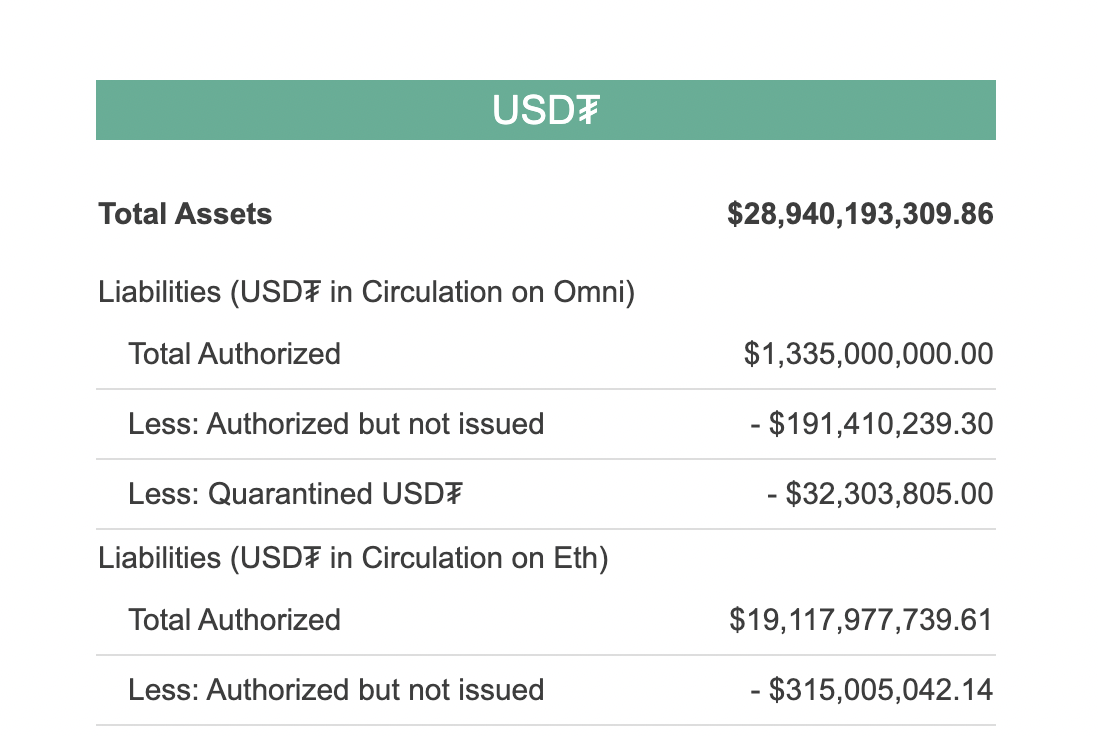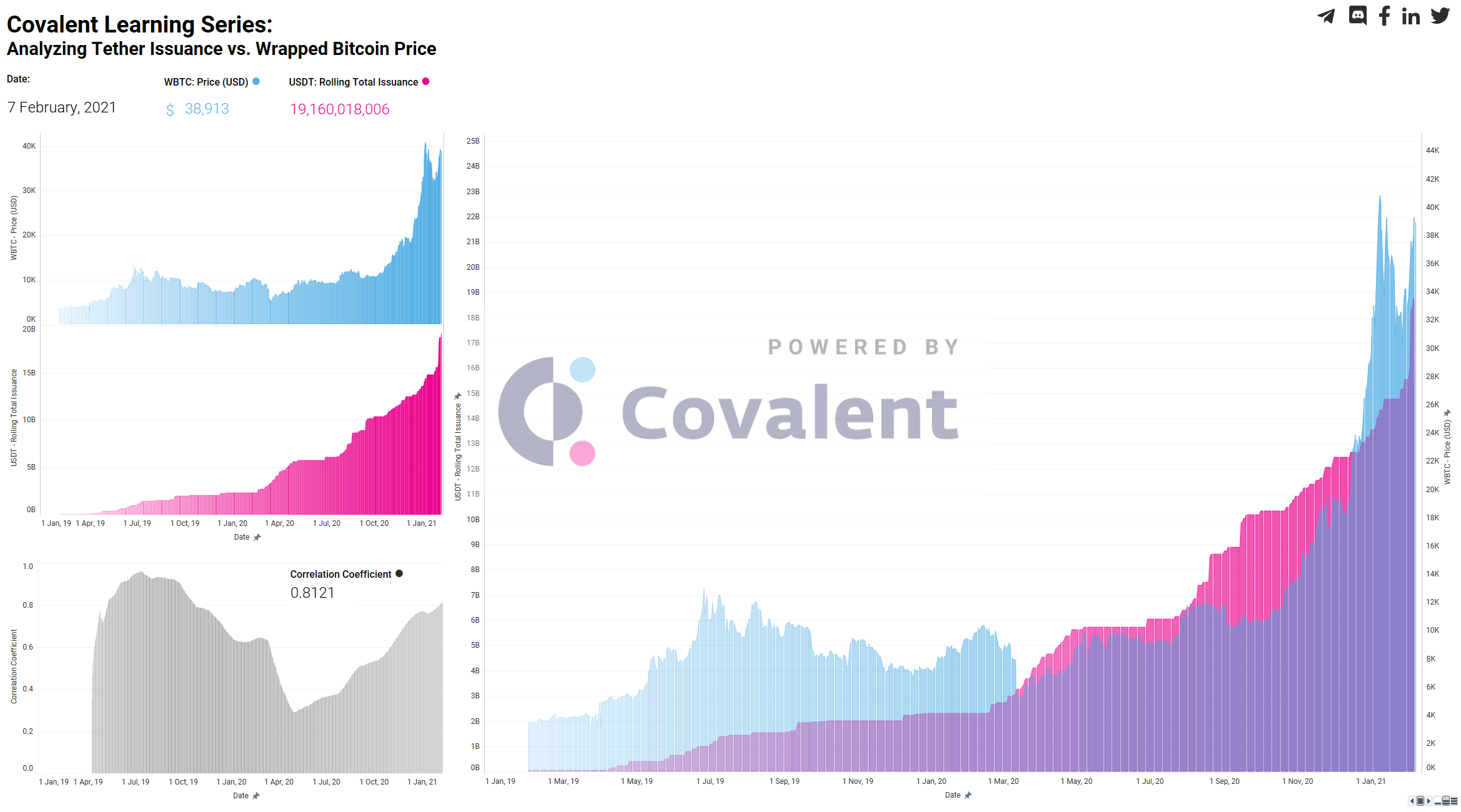
Analyze Tether issuances
Introduction
Tether is a blockchain-based cryptocurrency whose tokens in circulation are declared to be backed by an equivalent amount of traditional fiat currencies, like the dollar, which are held in a designated bank account. Tether tokens, the native tokens of the Tether network, trade under the USDT symbol, and belong to the group of cryptocurrencies called stablecoins.
There is no shortage of controversy around Tether (see https://crypto-anonymous-2021.medium.com/the-bit-short-inside-cryptos-doomsday-machine-f8dcf78a64d3) but the purpose of this case study is to understand how we can use the Covalent API to do our own Tether analysis and see if the underlying blockchain data tells us the same story as what Tether publishes on their Transparency Dashboard.

Endpoints Summary:
The key Covalent API endpoints covered here are:
-
v1/{chainId}/events/topics/{topic}/- Return a paginated list of decoded log events with one or more topic hashes separated by a comma.
-
v1/pricing/historical/{quote_currency}/{ticker_symbol}/- Get historical prices for a
ticker_symbolin a particularquote_currency. Can passtoandfromdates. By default, it returns the current price.
- Get historical prices for a
Prerequisites
While no coding is required to carry out the analysis, we will be using the Covalent API feature of csv data exports and Google Sheets to filter and plot the data.
Extracting the USDT contract Issue events
1) Find the USDT smart contract address, contract decimals and starting block
In order to get the timeseries data of when USDT was minted and the amounts, we need to look at the USDT smart contract code. To find the smart contract, we can simply go to Etherscan and search for USDT.
The contract decimal refers to the base units of USDT so a value of 1000000 USDT base units refers to 1 USDT.
If we take a look a the contract code, we see that when new tokens are issued, an event Issue(uint amount) is logged. These tokens are deposited into the owner’s address. Note on the Tether Transparency Dashboard, issued tokens are actually referred to as Total Authorized, as they may not be circulating.

On Etherscan, we can also see the transaction when the USDT contract was created: https://etherscan.io/tx/0x2f1c5c2b44f771e942a8506148e256f94f1a464babc938ae0690c6e34cd79190.

2) Find the Issue event topic hash
This step is harder to do on Etherscan because it requires having to scroll through many log events to find the Issue event, and even then the number of log events displayed is limited. Luckily our Topic Hash Calculator makes this simple to find.

We simply paste in our USDT contract address, 0xdAC17F958D2ee523a2206206994597C13D831ec7 and we get the Issue topic hash:
3) Get all the USDT Issue events
We now use the Covalent API GET log events by topic hash endpoint with the following parameters. Note that the Covalent API currently limits the block range between the starting-block and the ending-block to 1 million blocks. Hence, this data will need to be fetched in batches of 1 million blocks.
| Parameter | Value |
|---|---|
chainId |
1 |
topic |
0xcb8241adb0c3fdb35b70c24ce35c5eb0c17af7431c99f827d44a445ca624176a |
starting-block |
4634748 |
ending-block |
5634748 |
sender-address |
0xdAC17F958D2ee523a2206206994597C13D831ec7 |
format |
csv |
From Etherscan, the current Ethereum mainnet block height, as of "2021-02-08T17:31:52Z" is 11817192. For the ending-block field, we can use the value latest to ensure we get data up to the latest block height.
- Increase the value of the
starting-blockandending-blockin increments of1000000until we can use anending-blockoflatest(currently11817192).
Also note that the sender-address is our USDT contract address.
Our response from the Covalent API looks something like this (only 1 record shown):
---
header: Get decoded USDT Issue log events in csv format
---
block_signed_at,block_height,tx_offset,log_offset,tx_hash,sender_address,sender_address_label,raw_log_data,raw_log_topics_0,decoded_name,decoded_signature,decoded_params_name,decoded_params_type,decoded_params_indexed,decoded_params_decoded,decoded_params_value
"2017-11-28T16:24:26Z",4638757,9,5,"0x8cfc4f5f4729423f59dd1d263ead2f824b3f133b02b9e27383964c7d50cd47cb","0xdac17f958d2ee523a2206206994597c13d831ec7",,"0x00000000000000000000000000000000000000000000000000000002540be400",,"Issue","Issue(uint256 amount)","amount","uint256",false,true,"10000000000"
"2017-11-28T16:24:26Z",4638757,9,5,"0x8cfc4f5f4729423f59dd1d263ead2f824b3f133b02b9e27383964c7d50cd47cb","0xdac17f958d2ee523a2206206994597c13d831ec7",,"0x00000000000000000000000000000000000000000000000000000002540be400","0xcb8241adb0c3fdb35b70c24ce35c5eb0c17af7431c99f827d44a445ca624176a","Issue","Issue(uint256 amount)",,,,,
We copy & paste this data into a Google Sheet and use Data -> Split text to columns to split the CSV data into individual columns.
Here is a copy you can fork if you would like to use for your own analysis: https://docs.google.com/spreadsheets/d/17GmBqd73_YLsb21yhfrOGt95P9L0rNAYhtKGIN8bx6Q/edit?usp=sharing
The Covalent API provides detailed, granular blockchain transaction data, including decoded log events. The values in the column decoded_params_value show the amounts of USDT issued but the units for these values are the USDT base units so we need to divide by 10^6 to get the actual USDT values.
If we do a quick sum of the decoded_params_value column and divide by 10^6, we get a value of: 19,160,018,006 USDT. Taking a look at the Tether Transparency Dashboard, we see the total authorized amount of USDT in Circulation on Eth to be: $19,117,977,739.61 USD so our value in USDT is within 0.22% of the Tether figure.
If we want to be even more precise, we can get and use the daily spot price of USDT, which fluctuates around the $1 USD value, with this Covalent API endpoint: GET historical prices by ticker symbol.
Summary
In this case study, we analyzed the amount of USDT issued by Tether to verify if the amounts highlighted on their Transparency Dashboard match the underlying blockchain data. We extracted a specific decoded log event (the Issue event) for the Tether token (USDT) contract, and summed the total amount issued since contract genesis. This process required us to:
- Find the USDT contract address and genesis data from Etherscan
- Use the Covalent Topic Hash Calculator which makes it simple to find the topic hash value of a log event
- Use the Covalent API and specifically the
Get Log events by topic hashendpoint which makes it easy to extract decoded blockchain transaction logs.
We determined that, to date, 19,160,018,006 USDT has been recorded as issued to the USDT contract owner’s address since 2017-11-28, which is within 0.22% of the $19,117,977,739.61 USD figure reported on the Tether Transparency Dashboard. The discrepency is due to the USDT/USD exchange rate which fluctuates around $1.
Next Steps
The reader can plot USDT issuances with the historical BTC price to determine the correlation using interactive data visualization tools like Tableau. Here is a sample dashboard with this plot:


























